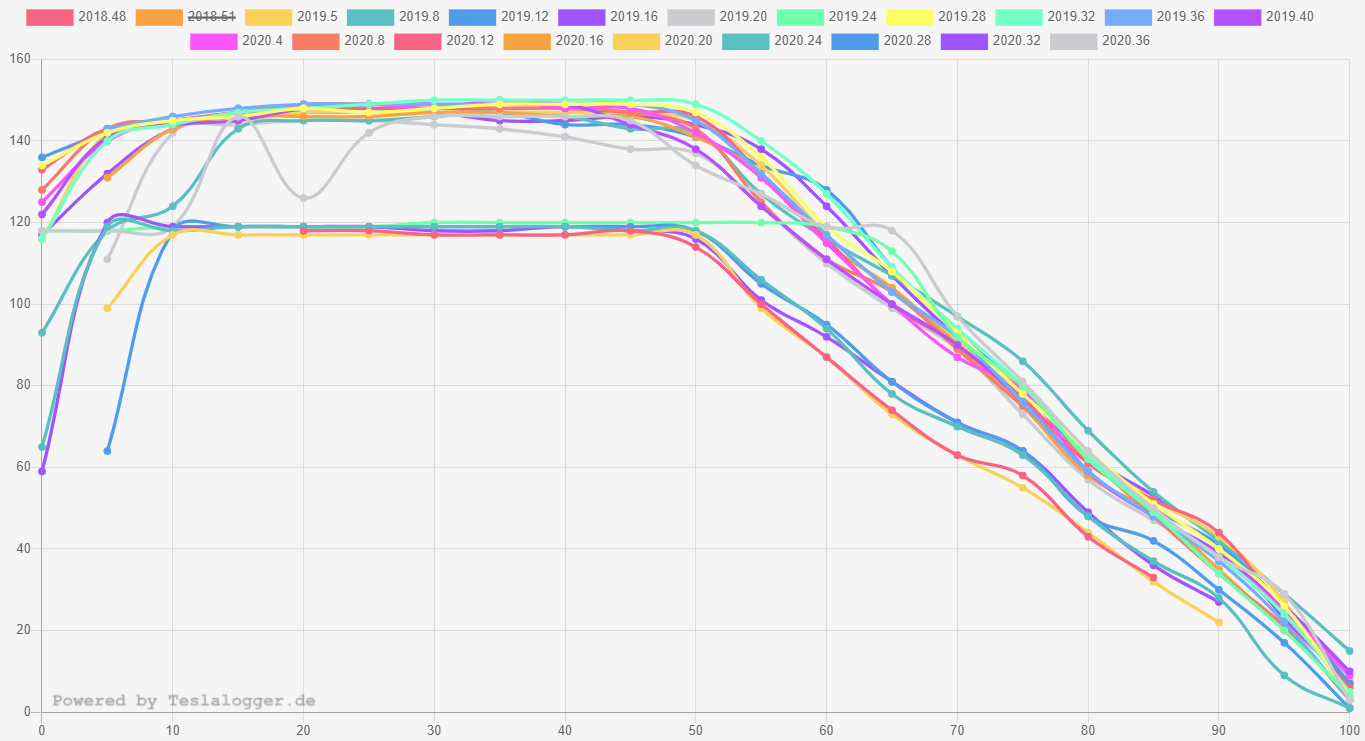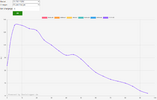Welcome to Tesla Motors Club
Discuss Tesla's Model S, Model 3, Model X, Model Y, Cybertruck, Roadster and More.
Register
Install the app
How to install the app on iOS
You can install our site as a web app on your iOS device by utilizing the Add to Home Screen feature in Safari. Please see this thread for more details on this.
Note: This feature may not be available in some browsers.
-
Want to remove ads? Register an account and login to see fewer ads, and become a Supporting Member to remove almost all ads.
You are using an out of date browser. It may not display this or other websites correctly.
You should upgrade or use an alternative browser.
You should upgrade or use an alternative browser.
Supercharging Speeds: Who, what, where, why, and when
- Thread starter wk057
- Start date
kavyboy
Active Member
Some more data, if anyone cares: I just did a 1500-mile road trip in a 2015 S70. My magic number (state-of-charge + kW) was pretty solidly at 105, with a +/- of only about 3 through most of the range between 10% and 90%. I hit 125 one time when plugging in with single-digit SOC, but it went back to 105-ish in a minute or two.
The magic number, when new, was 120 with +/- of about 8. Right after the big nerf, my magic number was solidly at 100 max, so I got a little back recently. I didn't really notice and real-world affect of the lower charging speed, as I was getting food or talking to people.
I'm at 33,000 miles on the odometer and version 2020.12.11.5.
The magic number, when new, was 120 with +/- of about 8. Right after the big nerf, my magic number was solidly at 100 max, so I got a little back recently. I didn't really notice and real-world affect of the lower charging speed, as I was getting food or talking to people.
I'm at 33,000 miles on the odometer and version 2020.12.11.5.
kaladanp85
Member
Could you reproduct this?Interesting. I wonder with my “a” battery that was always limited to 90 kW whether this risk even exists… and supposing I am probably unnecessarily “chargegated”. Double whammy!
Also interesting that the 75D 400V seems not to be affected (anymore), but it should be the same 85kwh Type Pack @wk057 ?
This recordings show the old curve.
Attachments
There's no 400V 75D (unless you're talking about "85"s that are actually 75Could you reproduct this?
Also interesting that the 75D 400V seems not to be affected (anymore), but it should be the same 85kwh Type Pack @wk057 ?

This recordings show the old curve.
Also, the chemistry issue was corrected with the v3 90 and 75 packs... forget the exact release dates on those, but shouldn't be hard to find.
kaladanp85
Member

Tesla strangely starts delivering new 85 kWh battery packs software-locked at 75 kWh
By discontinuing its Model S option for a 75 kWh battery pack software-locked to 60 kWh, Tesla removed all software-limited battery...
 electrek.co
electrek.co
There are some S and X's, I guess early cars, labelled with 75D but got the "85kwh" 400V Packs with old chemistry.
The charging curve shows exactly what 85/P85/P85D charged in their glory Years.
...but theres No need to software lock them to mach the numbers
@aerodyne
could you reproduce this rates on a v3 suc ?
Like most 85 packs, been charge gated.
30-80% went from 30min to 45min in 2019.
Just now however, saw 80Kw at 40%, and 65kw at 50%, 51Kw at 60%.
Seems like I am approaching the "BH rule" of 120-130 (SoC plus Power)
Perhaps the algorithm is taking into account my mild driving habits and lack of SuC.
Or it could be that I try to avoid getting the pack too warm or too cold. Range mode keeps the pack warm with out pack heater on, 107 deg F seems to be the sweet spot, no AC comes on.
Last edited:
Florian500
Member
dark cloud
Active Member
And then there is Audi's take on charge curve. Better cooling design? No idea if this rate changes after 100,000/200,000 miles though.
Audi E-Tron fast charging: Why predictability was a priority over peak power
Audi E-Tron fast charging: Why predictability was a priority over peak power
trayloader
Member
trayloader
Member
Charge gating started on the 90 packs again with the latest update 
No2DinosaurFuel
Active Member
Which version so I know not to upgrade to it. Thanks.Charge gating started on the 90 packs again with the latest update
trayloader
Member
ElectricIAC
Good-Natured Rascal
I think all BTX4/5/6Charge gating started on the 90 packs again with the latest update
Anth89
Member
Concerning the BTX6 (100D) I don't exactly confirm. I have still reached a peak of 142KW last week-end (I'm on the 2021.40.6, 100D from 2017).
The car has however difficulties to stabilize at that level and the charging speed usually drops quickly somewhere in the 125 to 135 KW range.
This was already similar last summer (so before the 2021.32). Can any other 100D owner share his observations?
The car has however difficulties to stabilize at that level and the charging speed usually drops quickly somewhere in the 125 to 135 KW range.
This was already similar last summer (so before the 2021.32). Can any other 100D owner share his observations?
ElectricIAC
Good-Natured Rascal
T

That jives with my latest observations on our BTX5 peaking @ 126KW rather than high 130-mid 140’s as on previous SW’s.Concerning the BTX6 (100D) I don't exactly confirm. I have still reached a peak of 142KW last week-end (I'm on the 2021.40.6, 100D from 2017).
The car has however difficulties to stabilize at that level and the charging speed usually drops quickly somewhere in the 125 to 135 KW range.
This was already similar last summer (so before the 2021.32). Can any other 100D owner share his observations?
ElectricIAC
Good-Natured Rascal
How did you get that graph out of Teslafi?just for interest, this is my supercharging speed since mid-2018 when I started using TeslaFi. the bluer the dot, the longer ago it happened:View attachment 665920
You can see pretty clearly that it used to hit 120kW and stay there to about 20%, then fell away pretty gradually all the way to 85%, before dropping steeply to 100%, now it still starts at 120kW (sometimes even 125, but it rockets down to 90kW by about 15% and then falls away gradually to 90%. I've removed all the datapoints where I was sharing, or the battery was cold etc. to get rid of the noise.
kavyboy
Active Member
Since I just got a "like", I'll put more info in here.Some more data, if anyone cares: I just did a 1500-mile road trip in a 2015 S70. My magic number (state-of-charge + kW) was pretty solidly at 105, with a +/- of only about 3 through most of the range between 10% and 90%. I hit 125 one time when plugging in with single-digit SOC, but it went back to 105-ish in a minute or two.
The magic number, when new, was 120 with +/- of about 8. Right after the big nerf, my magic number was solidly at 100 max, so I got a little back recently. I didn't really notice and real-world affect of the lower charging speed, as I was getting food or talking to people.
I'm at 33,000 miles on the odometer and version 2020.12.11.5.
I just did a 2,500 mile trip. The 105 number was nearly a constant at all SOC, from 6% to 95%. The old 120 number used to taper down at higher SOC, but I saw no evidence of that at all.
It did seem like the charging stops were longer now. However, I had two dogs that needed walks and I hadn't packed clothes that were warm enough, so stops were pretty miserable.
sorka
Well-Known Member
Will have to go back through this and do some specific responses at some point.
Suffice it to say, it turned out that fast charging was very bad for the 60/70/85 packs. It's an odd phenomenon also... as in, the damage done is virtually undetectable even at the cell level until it's too late. Once it's too late, the cell's IR goes up exponentially to the point where it just cant charge/discharge anymore (the failure section is over the course of about 100 cycles).
This actually eventually happened to all of my cells I had under supercharge-equivalent long-term testing, and I've sent some of them to a lab that was interested in the results to breakdown and analyze why this actually happened. Preliminary findings show some sort of insulating/isolating material is built up during high stress charges. Once that buildup crosses a threshold, further charging spreads it more quickly across the plates until the cell reaches the point where charging doesn't supply enough energy to produce/release this insulator. The actual material may be some additive that is precipitated or otherwise chemically produced. I don't really know. I'm also not a chemist. While I have a decent understanding of the principals involved, my terms are probably off here. Still waiting on more details (probably won't get any more info until next year).
The odd thing is that my own testing shows this to be very random. In my testing the first cells didn't show signs of the issue until well over 500,000 equivalent fast charge miles, and some reached around 900,000 fast charge miles. On the other hand, I have 20kW-equiv test cells with almost 2,000,000 miles of equivalent charges showing under 20% degradation, tapered to the point where I'd be surprised if they ever even fail... so fast charging is definitely a factor.
Tesla seems to have discovered this potential issue, ran the numbers on their end, and came up with new thresholds and metrics for how much fast charging to allow and at what levels on these "legacy" chemistries. Since about late 2019, the BMS firmware of all of the pre-100 pack vehicles has an algorithm to calculate fast charge and taper rates based on historical usage data. I've dissected it as best possible from a reverse engineering standpoint, and while the exact thresholds that cause a substantial decrease in charging speed can vary greatly based on different metrics, the maximum rates and best taper rates are much lower than what they could have been previously even on the best packs.
The worst possible output of the new function comes out to about 1/4C CC rate. (So, for an "85" pack that'd be about 19 kW since ~75 kWh real capacity / 4). The worst I've seen in the wild maxes out at 42 kW. This seems excessive.
What's odd (telling?) is that the old charge rate code section is what is used to output the estimated charge time remaining on these packs, even as of the latest code I've looked at (few months ago). This is why, for example, an 85 will start at say, 50 minutes remaining, and 90 minutes later say 20 minutes remaining. Estimates based on the real power data would be more accurate, but would show things like 2+ hours remaining on the screen of some of the worst impacted vehicles... which would probably be worse for PR than showing 30 minutes for 90 minutes.
Anyway... IMO, I think Tesla is being a little too CYA on this one. With the older charge profile, even under the worst conditions in my tests, cells didn't show issues until well past what you'd expect the life of a normal vehicle to be. So people still on older firmware charging faster on their 85s are not likely in any serious danger of having problems. (Barring unrelated BMS issues described elsewhere.)
To be very clear, the issues posed by this are not catastrophic failures (like fire, shorts, explosions, etc). The failures are essentially full degradation down to single digit % original capacity... which would never even happen in a real car anyway since the BMS would freak the heck out long before it got to that point.
Keep in mind that there are other minor factors that Tesla may be taking into account, such as the wear on older vehicle hardware (fast charge contactors or contacts in charge port connectors, for example) that I'm not fully aware of the details on. These definitely have an impact on the safety of fast charging, and there's no technical way for Tesla to measure these items in firmware to determine condition... so I could see them using a low-end real world test metric for that input data, resulting in lower charge rates.
I think Tesla should undo this particular change, since it impacts the usability of older vehicles greatly. I don't think they will, however, for a variety of reasons... not the least of which is that I'd guess it presently has a net positive effect on their bottom line.
TL;DR - Tesla slowed fast charging on pretty much every car produced before about 2017.
I have about 57K kWh charged and 54K kWh discharged. Just about 50% is supercharging or about 360 complete cycles. Of the remaining 50%, half of that is charging at home at 19.2KW.
I have 130K miles now. Range has fallen to 231 miles out of the original 253. (71.9kwh usesable down from a fraction over 77 when new.
My mv max difference at 90% is 6 mv but half of that is from module 58. If it wasn't for that module, it would be a 3mv diff between the remaining modules.
5 miles of range lost over the first month after going from v8 to v10 when I did the MCU update back in March and then it leveled out so it looks like I have small amount of range capping after all.
Since that update, I have an odd BMS behavior. If I drive a long time and say park at 30%, an hour later, it will rise to 33%. Vampire drain is all over the place. Some days sitting in the garage it'll go down 1% in 24 hours and some days it's 6%.
Tesla's charge taper has resulted in me changing my strategy when traveling on long trips. I now always charge to 100% before leaving on a long trip so that my first supercharging leg has less time than when I left with just enough charge to get to that first supercharger.
Also, on a long trip, if we stop for a meal, rather than me getting up during the meal to move the car when I have enough juice for the next leg plus a 10% buffer, I just set the charge to 100% and don't worry about moving. After 98% or so, it charges so slowly that I don't have to worry about idle fees.
I use to baby the battery and charge as little as possible to reduce max SOCs. Now I don't care. Tesla has forced me to do this to compensate for the slower taper.
This chart shows supercharging sessions the last few days before the MCU2 upgrade and the first several charges the following days:

Making sure the battery is warm before arriving and it's slightly improved to about SOC+KW=110 most of the time. If I arrive at a super busy 250KW super charger station, then I get the bonus speed and that combined rate jumps to 120. This is almost certainly some sort of signal by Tesla to raise the max limit to reduce supercharger crowding. I've seen it a dozen times now and it never fails.
sorka
Well-Known Member
Thanks for the Information, wk.
From your expertise, Is there any interrelation to the Battery Pumps and Powertrain Pump running at 100% for hours after charging to 78% SOC?
Any interrelation to the high vampire drain on firmware 2020.48 (on MCU1, not caused by MCU upgrade...) ?
Thank you!
This hasn't effected me one bit. I still never leave the car sitting at anything over 70%.
sorka
Well-Known Member
Thanks wk057 for more updates. If Tesla was the company it was before, it would silently give everyone a new pack and it will still probably not affect their bottom line much given how many money they are making this year. Heck they can just sell all there BTC and use the profit to fix all those old cars. But sadly I guess Musk is trying to hold on to his title as richest man. That would not be good for his net worth when people hear about him giving early adopters free battery pack replacements.
It WOULD have effected their bottom line. I would have bought a new Tesla after my current one. Now I'm not ever going to touch their vehicle products again. Hoping the 3 powerwalls don't bite me later too.
Similar threads
- Question
- Replies
- 8
- Views
- 2K
- Replies
- 38
- Views
- 3K
- Replies
- 5
- Views
- 134
- Replies
- 7
- Views
- 1K



